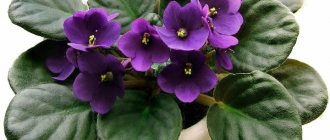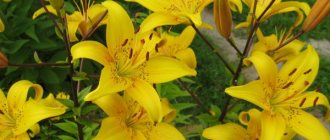Evening Primrose, Night Beauty
- Font size: More Less
- Subscribe to updates
For several years in a row, I have been growing biennial evening primrose in my garden, or it is also called night beauty or night candle. I remember buying seedlings of some flowers, and my grandmother gave me seedlings of this evening primrose as a gift. I planted it in the shade under an apple tree, where nothing ever grew, since I didn’t like its foliage at all, and I had never heard of this flower until that moment. Imagine my surprise when the two-year-old evening primrose not only grew but also bloomed.
It bloomed in the evening and unfortunately for the first few days I could not catch the moment the flowers opened. But she amazed me: from some limp green leaves a meter-long bush with large lemon-colored flowers grew. It burned in the night like a candle, it’s not for nothing that people call it “Night Candle.” But what was my delight when I first saw how the flowers of the night beauty, evening primrose, began to open at sunset.
I only saw this on TV when they showed a flower blooming in quick motion. The bud burst, and as in a fairy tale, the pestle began to rotate and the petals untwisted and opened. I called all my relatives and we began to observe the further blooming of the biennial evening primrose. The whole bush was literally moving, and before our eyes, large, fragrant, bright yellow flowers of the night candle were opening here and there. In the garden there were only sounds of admiring cries: “Look, this one is opening, and here’s another one...”. We stood in the garden until it was dark, until the last flower bloomed. Probably this fabulous evening remained in the memory not only of me, but also of my loved ones.
The next day we were already waiting for sunset to see this spectacle again and experience a storm of emotions. We took a video camera with us and recorded this fabulous performance. So what happened from the ugly duckling was a charming swan.
By lunchtime, evening primrose flowers close. And in the evening the fairy tale repeats itself again. Evening primrose blooms from June to October, until the first frost.
You can buy night beauty or evening primrose in Kursk by calling tel. 8-952-493-54-34
Flowers that bloom at night
Night flowers are truly a miracle of nature. They bloom their petals at night. The most popular ones are listed below :
Mirabilis
The mystery of the Mirabilis night flower begins with its name. From Latin “mirabilis” is translated as “amazing”. It surprises with its varied colors and ease of care . If you plant several different types of mirabilis next to each other, the color scheme will change next year. Flowering will be of different colors on the same bush. Due to the fact that the plant blooms at night, it is called “night beauty”. It blooms in the evening and blooms until the morning, exuding a pleasant aroma.
Mirabilis
Mirabilis lives for several years, provided there are no harsh winters. In regions where winters are quite cold, it is considered an annual.
Mirabilis can be propagated in different ways.:
- Seeds
- Dividing the bush
- By cuttings
- Digging up a root for the winter
Seed propagation is the simplest and most effective. In the southern regions, mirabilis reproduces by self-sowing.
Dividing the bush can be done provided that the bush has a well-grown root. Dig up the plant and divide the root with a shovel or knife. The separated parts are planted in different holes.
The method of propagation by cuttings is extremely complicated and not always effective. As a rule, I use it when there is no other way to preserve the appearance of the plant. To do this, take a woody shoot. The cut on the shoot is dried, dipped in a growth stimulator and allowed to take root in water or soil.
They dig up the root for the winter in regions with cold winters . The root is stored in sand, maintaining the humidity level. This method is rarely used. Because it is extremely rare to preserve the root due to the difficulty of maintaining the required humidity. The root either dries out or rots.
Vechernitsa
Vessel, otherwise called Hesperis, is due to the fact that it blooms in the evening. The leaves of the noctule plant are entire and pinnate. Hesperis flowers can be purple, yellow or white. The noctule bush can reach 75 centimeters in height . The flowers are small in size.
Eveningweed or Hesperis
Eveningwort is a frost-resistant, unpretentious plant. The noctule blooms for about two months. Flowering depends on weather conditions.
Propagated using seeds . You can buy them in a store or assemble them yourself. It also reproduces well by self-sowing.
Plant in late spring and summer or autumn. But it will bloom only next year.
It is necessary to plant the noctule at a distance of 30-40 centimeters . The plant is light-loving. The soil for planting noctule requires fertile and loose soil.
Evening primrose
Evening primrose is an amazing plant that reveals its beauty at sunset. Also called Night Candle and Oslinnik.
Nocturnal plants
There is a huge variety of plants, thanks to which it is always possible to create colorful and unusual flower beds.
Most flowers bloom during daylight hours, but there are also nocturnal plants that begin to smell and bloom at night. Some of them bloom both day and night. Nocturnal plants are pollinated by insects and small mammals such as bats. Indoor plants that bloom at night pollinate themselves or require artificial pollination.
Among the most famous nocturnal plants is night violet or hesperis (popularly called nocturnal plant). As evening approaches, the crimson flowers of the nocturnal plant begin to smell intensely. The nocturnal plant is a biennial and tolerates winter cold well without additional shelter.
The perennial evening primrose also appears in all its glory only in the evening. Large flowers have a pleasant aroma that fills the entire garden. Evening primrose requires some care and attention. Evening primrose is used to create rocky hills, borders, and mixborders.
Annual matthiola is grown for its beautiful flowering. In the evening, the honey aroma of the flowers intensifies. It is especially pleasant to spend evenings in the gazebo, next to which matthiola is planted. It is often used for landscaping balconies.
Sweet tobacco
Belongs to the nightshade family. The height of the bushes is 0.5-0.9 meters. Star-shaped flowers. The color ranges from white to bright red, and the more faded the color, the stronger the smell. Flowers open at night. Fragrant tobacco blooms all summer.
An annual crop that prefers warm climates. It is mainly planted as seedlings. They are transferred to open ground in mid-May, when the soil has warmed up well. Unpretentious in care. Loves abundant watering and timely removal of flowers that have begun to fade. Fertilizing with nitrogen fertilizers is only necessary when planting in poor soil. This crop produces phytoncides, so gardeners often supplement their flower beds with it in order to protect other plants from pests.
Night flowers... They are magical
There are so many interesting things around us. All you have to do is open your eyes and enjoy. Flowers... They are simply magnificent creations of nature. Girls love beauty very much and that is why they are so partial to such fragrant plants.
Some representatives of the flora bloom once every 300 years, and this happens, although many did not even think that they were able to live that long in principle. But, still, there are so many beautiful things that in everyday life, because of the bustle, people don’t even think about. People have stopped paying attention to everything around them, but how nice it is to see and know the secrets of nature.
Alyssium
A beautiful night flower for those who love delicate white rugs. The main advantage of alyssium is that flowering does not stop until frost, that is, a pleasant aroma in the country is guaranteed for the whole season.
Related article:
How to transfer lilies of the valley from the forest to the site
When planting, you need to select places where dampness does not stagnate, since alyssium is afraid of increased moisture.
Wonderful mirabilis
Mirabilis jalapa is the most common representative of this species. Mirabilis flowers usually open in the evening, emitting a strong sweet aroma.
But the most amazing thing is not even this, but the fact that even on one mirabilis bush there can be flowers of different colors. This wonderful plant's flowers change color as they grow - from yellow, for example, to dark pink, and white ones can turn into purple.
Mirabilis flowers are used as food coloring. Its leaves are conditionally edible (it is better to eat them only when there is nothing else). Traditional medicine uses mirabilis as a laxative, a means to heal wounds and relieve swelling.
It is believed that mirabilis root improves potency, the main thing here is not to overdo it - do not forget about the laxative effect!
Matthiola, or gray-haired left-wing (Matthiola incana)
Levkoy is a familiar ornamental, beautifully flowering garden plant with fragrant flowers. But few people know that this representative of cruciferous plants is pollinated precisely by nocturnal insects.
Matthiolas are excellent honey plants; in addition, many of their garden forms of different sizes have been bred, single- and multi-stemmed, with simple and double flowers of different shades (white, lilac, red, pink, purple), collected in loose racemose inflorescences of various lengths and shapes. Like most night flowers. Although it blooms not too late in time, the aroma of matthiola noticeably intensifies with the onset of dusk.
In the garden, Levy is cultivated as an annual; on your site it will prefer a well-lit and well-drained corner with neutral acid soil in a sunny place.
Lotus Brahma-Kamal
Mountain lotus “Brahma-Kamal” (bitterberry), which is also called the Flower of the Gods, is native to India, Northern Burma and southwestern China. In the Himalayas, the flower grows even at an altitude of 4500 meters.
The petals of the Flower of the Gods begin to open immediately after sunset; it blooms for only one night. “Brahma-Kamal” is a hermaphrodite plant, pollinated by insects. It is often used in Tibetan medicine, especially to treat the urinary and reproductive systems.
The Indian god Brahma is often depicted sitting in a pink lotus (in Sanskrit - “kamala”), which, by the way, is the national Indian flower. But more often it is believed that this is not a water lotus, but a mountain lotus - bitterberry.
According to legend, good luck, prosperity and happiness will come to the house where the bitterberry blooms.
Epiphyllum - queen of the night
The Queen of the Night, or epiphyllum, popularly called the “Dutch pipe”, is one of the most popular and widespread cacti native to Central America and northern South America. “Queen of the Night” blooms extremely rarely and only at night. Often the buds ripen for a whole year, but even in such cases the flower does not please the eye for long - the sun rises and the luxurious bud already fades.
The Chinese use the character for epiphyllum to describe someone who quickly became famous and just as quickly “faded”—“califa for an hour.”
Dragon fruit chylocereus
Chilocereus are called “Night Cacti” because they bloom only at night. Their flowers are white, large, with a pleasant smell and a typical cactus shape. Just like epiphyllums, chylocereus blooms for a short time - less than one night.
After 30-50 days, pitayas ripen in place of withered flowers, they are also dragon fruits, they are also called strawberry peaches. Under natural conditions, the fruits of this cactus ripen 5-6 times a year. Each fruit weighs from 150 to 600 grams.
They grow in Central and South America, and in Southeast Asia they are grown on plantations.
Vechernitsa
- perennial
When evening comes, it is impossible to pass by this lovely flower! The cool, sweet aroma of evening grass removes traces of fatigue, gives warmth and joy even on the most bad weather. Large lilac tassels look spectacular both in a flowerbed and in a bouquet, charming with their romantic appeal.
Growing conditions: perennial noctule is extremely unpretentious. Sowing to a permanent place in June. Grows best in loose soil, in sun or partial shade. Overwinters without shelter. Transfer: September.
Drooping pitcher
A perennial small herbaceous plant from the carnation family, which is also called the Nottingham flycatcher, at one time it was chosen as the national plant of Nottingham County.
It is interesting that now, during the day, it cannot be found either near Nottingham Palace or in the county itself. But in Europe and in Latvian fields it is very common.
Due to the characteristics of pollination, the drooping gum blooms three nights in a row, opening one stamen each night.
Protecting pollen from dew
Why do hydrangeas have green flowers?
Pollen is very important for plants, because through it they reproduce. During the night, dew accumulates on the flowers, which can damage the pollen. Moisture makes the pollen hard and pollinating insects cannot transfer it from flower to flower. Thus, plants closing at night created protection against extinction.
Night gladiolus
Gladioli are gorgeous! Every time you are amazed how a tiny onion, planted in the spring, can turn into such a luxurious plant by the end of summer, covered with many flowers and leaves like short blades! Translated from Latin, “gladiolus” means “short sword”.
There are more than 260 species of gladioli in the world, and since the beginning of the 19th century, when work on the selection of gladioli began, more than 10,000 varieties of these beautiful flowers have been created. More than 1000 of them can be found in Latvia.
Lily Casablanca
Surely you have seen these flowers. Casablanca is widely used in perfumes and weddings. It belongs to the genus of lilies, numbering more than 110 varieties. Each flower has 6 petals, colors vary from white, yellow, purple, orange and pink. Just imagine how beautiful it will be if you plant all the colors of this lily in the garden. Casablanca's flowers are elegant, delicate, and also smell great.
Brugmansia, or fragrant datura
Brugmansia or Datura is often called the “prickly” or “devil’s apple”. The flowers of this luxurious plant can reach quite impressive sizes and smell very tasty.
Although Datura blooms during the day, you can truly enjoy its beauty on warm, quiet summer evenings. During the day, Datura flowers are half-closed and drooping, but in the evening they open their buds and lift their leaves.
Despite their tropical origins and impressive appearance, almost all daturas are native to South America and do not require too high a temperature to breed. But they must also be protected from the winter cold; it is best for Datura to overwinter in greenhouses and cellars.
Under natural conditions, datura reaches 3-5 meters in height. The plant is very poisonous; in ancient times it was used to get rid of enemies.
Night water roses
Photo: Flickr upload bot/cc
This tropical plant is hard to miss. Purple-red or pink water roses bloom at sunset, standing out beautifully against the dark water.
These water roses are distinguished by their hardiness and larger flowers - their petals are 19-20 centimeters, the flowers can reach 25 centimeters in diameter. At night, water roses emit a faint but pungent aroma.
Alyssum
This subshrub is also widely known as alyssum . The plant is low-growing, herbaceous. Height can vary from 20 cm to 40 cm. Strongly climbing shoots grow widely, intertwining with each other. There are flowers on the shoots - small, with four petals. Their colors come in a variety of colors - white, pink, lilac, purple, lilac, yellow. The flowers, although unremarkable in appearance, bloom very densely and create the appearance of a dense carpet.
And although alyssum flowers cannot boast of a bright appearance, they have a very bright aroma - they smell sweetly of honey, and with the onset of night this intoxicating aroma only becomes stronger and more distinct. Therefore, a flower planted on a site can perform not only a decorative function, but also play the role of a honey plant . Alyssum blooms for a long time.
Night candles
Night candles, sun splashes, evening primrose - this is the name of evening primrose. And it’s clear why: most species of this plant bloom in the evenings and bloom all night with yellow, white, purple, and less often scarlet flowers.
Native to North America, evening primrose grows in rocky, dry, infertile areas.
Evening primrose is widely used in medicine. The first to discover its healing properties were the American Indians, who soaked primrose flowers in warm water and treated bruises and skin diseases with warm compresses.
A decoction of evening primrose root is an excellent cough remedy. Evening primrose is often called the “queen of herbs” that heals everything, but modern research does not confirm this thesis. However, evening primrose oil is an excellent remedy for relieving premenstrual syndrome.
Hesperis
It is a perennial plant, but is considered a two-year crop, since it most often dies in the third year. The herbaceous flower can reach a height of 1 meter. It blooms with small lilac flowers, collected in elegant, loose panicle-shaped inflorescences. Flowering continues from late May to early August.
Varieties with white, purple flowers, double and simple shapes are known in cultivation. All varieties have a unique aroma, which manifests itself most clearly at night.











